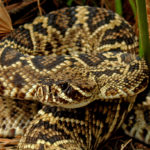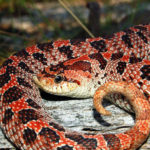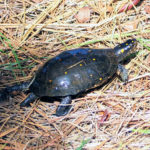 |
The Carolina Gopher Frog is state listed as North Carolina endangered. These rare frogs occur at scattered localities in the Sandhills and southeastern Coastal Plain. Little is known about their natural history outside the breeding season. Adults are secretive, spending most of their lives underground. |
 |
Eastern Box Turtles live in a variety of habitats throughout North Carolina. Although they can live in a variety of habitats, they prefer moist forested areas with large amounts of underbrush. They do not travel far, usually living within an area less than 200 meters in diameter. |
 |
The eastern diamondback rattlesnake is North Carolina endangered, but may have been extirpated because none have been seen in the state since the early 1990’s. The eastern diamondback Rattlesnake receives no federal protection despite the fact that it has declined over much of its range. |
 |
The Marbled Salamander, North Carolina’s state salamander, is relatively common throughout the state. Marbled salamanders prefer to live in damp woodlands that are close to floodplain pools and ponds. Like the mole, from which this family of salamanders gets its common name, mole salamander, marbled salamanders create burrows and tunnels, and spend most of their time underground. |
 |
The southern hognose snake is North Carolina threatened. These snakes are found in sandy fields and woods of the Coastal Plain and Sandhills region of the state. It is a secretive snake that spends much of its time under surface litter of underground. |
 |
Eventhough they are a very common salamander in North Carolina, most people have never seen a spotted salamander because they spend 95 percent of their lives on the forest floor under leaf litter, in hollow logs, or small holes in the ground. |
 |
The spotted turtle is not an officially protected species, but the U.S. Fish and Wildlife Service considers the spotted turtle an at-risk species – one that will be evaluated for listing under the Endangered Species Act. It is also on the North Carolina animal watch list as a species whose population is known to be declining. They live in the eastern half of the state in a variety of wetland types, including swamps, bogs, marshes, small streams, wet meadows, and wet forests. |













